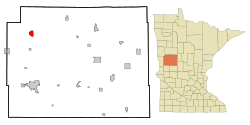Dahlgren Township is a rural township in Carver County, Minnesota, United States. The township's economy is based on commercial agriculture around dairying, livestock and cash grain farming. The population was 1,453 as of the 2000 census.

Victoria is a city in Carver County, Minnesota, United States. The population was 10,546 at the 2020 census.

Manhattan Beach is a small city in Crow Wing County, Minnesota, United States, near Crosslake. The population was 57 at the 2010 census. It is part of the Brainerd Micropolitan Statistical Area.

Nisswa is a city in Crow Wing County, Minnesota, United States. The population was 1,971 at the 2010 census. Nisswa is part of the Brainerd Micropolitan Statistical Area, near Gull Lake.

Mendota Heights is a city in Dakota County, Minnesota, United States. It is a first ring southern suburb of the Twin Cities. The population was 11,744 at the 2020 census.

Rosemount is a city in Dakota County, Minnesota, United States, on the southern edge of the Twin Cities Metropolitan Area. The population was 25,650 at the 2020 census.

Maple Plain is a city in Hennepin County, Minnesota, United States. The population was 1,768 at the 2010 census.

Tonka Bay is a city in Hennepin County, Minnesota, United States. It is located on Lake Minnetonka between the upper and lower lakes. It gained some popularity in the 1880s and 1890s as a summer lake resort. The population of Tonka Bay was 1,475 at the 2010 census.

Hallock is a city in and the county seat of Kittson County, Minnesota, United States. The population was 906 at the 2020 census.

Glencoe is the county seat of McLeod County, Minnesota, United States. The population was 5,631 at the 2010 census.

Lester Prairie is a city in McLeod County, Minnesota, United States, along the South Fork of the Crow River. The population was 1,730 at the 2010 census. Noted composer and conductor of The Concordia Choir, Rene Clausen was raised in Lester Prairie.

Buhl is a city in Saint Louis County, Minnesota, United States. Its population was 1,000 at the 2010 census.
Rice Lake is a city in Saint Louis County, Minnesota, United States. The population was 4,112 at the 2020 census.

Browns Valley is a city in Traverse County, Minnesota, United States, adjacent to the South Dakota border. The population was 558 at the 2020 census.

Wheaton is a city in Traverse County, Minnesota, United States. The population was 1,460 at the 2020 census. It is the county seat.

Montrose is a small city in Wright County, Minnesota, United States. Montrose is surrounded by farmland, prairies, and lakes. The population was 2,847 at the 2010 census.

New Germany is a city in Carver County, Minnesota, United States. The population was 372 at the 2010 census. A large proportion of the early settlers being natives of Germany caused the name to be selected.

Howard Lake is a city in Wright County, Minnesota, United States. The population was 1,962 at the 2010 census.

Ortonville is a city in Big Stone County in the U.S. state of Minnesota at the southern tip of Big Stone Lake, along the border with South Dakota. The population was 2,021 at the 2020 census. It is the county seat of Big Stone County. Big Stone Lake State Park is nearby.

Dayton is a city in Hennepin and Wright counties in the U.S. state of Minnesota. The population was 7,262 at the 2020 census. Dayton is mainly located within Hennepin County, but a part of the city extends into Wright County as well. It is the northernmost city in Hennepin County and is a suburb of the Minneapolis–St. Paul "Twin Cities" metropolitan area.





















